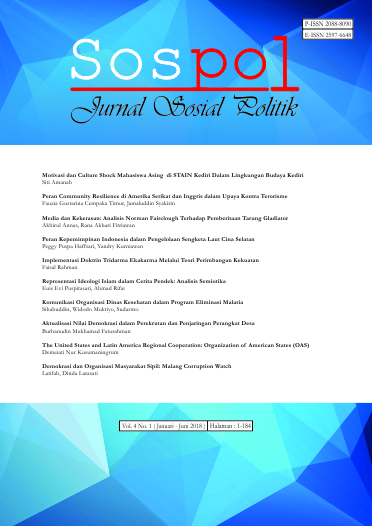Implementasi Doktrin Tridarma Ekakarma Melalui Teori Perimbangan Kekuatan
DOI:
https://doi.org/10.22219/sospol.v4i1.5125Keywords:
Doktrin Tridek, Perimbangan Kekuatan, Geografi, Teknologi, KoalisiAbstract
Abstrak
Tulisan ini menganalisis tentang implementasi Doktrin TNI yaitu Doktrin Tridarma Ekakarma (Tridek) dengan menggunakan Teori Perimbangan Kekuatan. Teori yang digunakan merupakan teori versi Barry Posen yang menggunakan tiga variabel, yaitu geografi, teknologi, dan koalisi. Teori tersebut berasumsi bahwa variabel teknologi merupakan variabel yang paling melihat ke arah luar negara dalam sebuah doktrin militer. Melalui teori Perimbangan Kekuatan, Doktrin Tridek dalam melihat ke arah luar negara memiliki berbagai kendala. Dalam variabel geografi, kendala utamanya adalah pemerintah dan TNI cenderung melihat ancaman berasal dari dalam negara. Dalam variabel teknologi, pemerintah telah melakukan berbagai upaya untuk mencapai MEF TNI yang diharapkan tercapai pada tahun 2024, namun salah satu kendala terbesarnya adalah terbatasnya anggaran yang dialokasikan oleh pemerintah untuk pemenuhan MEF TNI tersebut. Dalam variabel koalisi, salah satu kendala terbesarnya adalah masing-masing negara dalam kerja sama pertahanan, khususnya kerja sama multilateral, mempunyai agenda dan kepentingan yang berbeda dengan negara lain sehingga menyebabkan kerja sama pertahanan tersebut terhambat kemajuannya. Namun, dari berbagai upaya pemerintah dan TNI melalui Doktrin Tridek untuk melihat ke arah luar negara, variabel koalisi merupakan variabel yang mempunyai pengaruh terbesar dalam implementasi Doktrin Tridek. Hal tersebut dapat dilihat dari dilakukannya strategi hedging oleh pemerintah yang dijalankan oleh Kementerian Pertahanan dan TNI melalui diplomasi pertahanan berjalan lebih baik jika dibandingkan dengan variabel-variabel lainnya yang memiliki kendala yang rumit.
Kata kunci: Doktrin, Geografi, Koalisi, Perimbangan Kekuatan, Teknologi
Abstract
This paper analyzes the implementation of TNI doctrine, Tridarma Ekakarma Doctrine (Tridek) by using Balance of Power Theory. Based on this theory, Barry Posen uses three determinant variables named geography, technology, and coalition. It assumes that technological is outwardly looking variable in a military doctrine. Through the theory of Balance of Power, Tridek doctrine in looking beyond the state has various constraints. In geographic variables, the main constraint is that the government and TNI tend to see threats coming from within the country. In technological variables, the government has made various efforts to achieve the TNI MEF which is expected to be achieved by 2024, but one of the biggest obstacles is the limited budget allocated by the government to the fulfillment of the TNI MEF. In the coalition's variables, one of the biggest obstacles is that each country in defense cooperation, especially multilateral cooperation, has different agendas and interests with other nations, causing such defense cooperation to hamper its progress. However, from various government and TNI efforts through Tridek doctrine to look beyond the state, coalition variables are the variables that have the greatest influence in the implementation of the Tridek Doctrine. This can be seen from the implementation of hedging strategies by the government run by the Ministry of Defense and TNI through defense diplomacy runs better when compared with other variables that have complex constraints.
Keywords: Balance of Power, Coalition, Doctrine, Geography, Technology
Downloads
Downloads
Published
How to Cite
Issue
Section
License
Authors who publish with this journal agree to the following terms:
- Authors retain copyright and grant the journal right of first publication with the work simultaneously licensed under a Creative Commons Attribution-ShareAlike 4.0 International License that allows others to share the work with an acknowledgement of the work's authorship and initial publication in this journal.
- Authors are able to enter into separate, additional contractual arrangements for the non-exclusive distribution of the journal's published version of the work (e.g., post it to an institutional repository or publish it in a book), with an acknowledgement of its initial publication in this journal.
- Authors are permitted and encouraged to post their work online (e.g., in institutional repositories or on their website) prior to and during the submission process, as it can lead to productive exchanges, as well as earlier and greater citation of published work (See The Effect of Open Access).

This work is licensed under a Creative Commons Attribution-ShareAlike 4.0 International License.



















